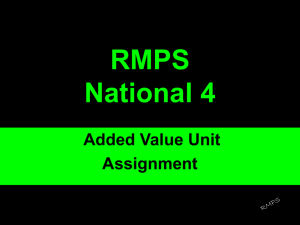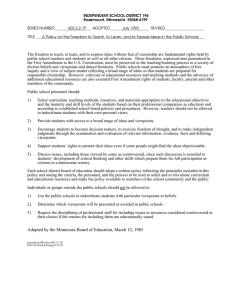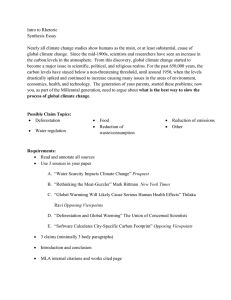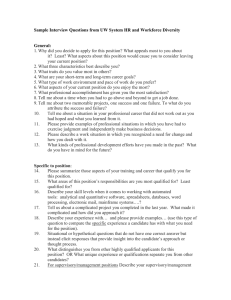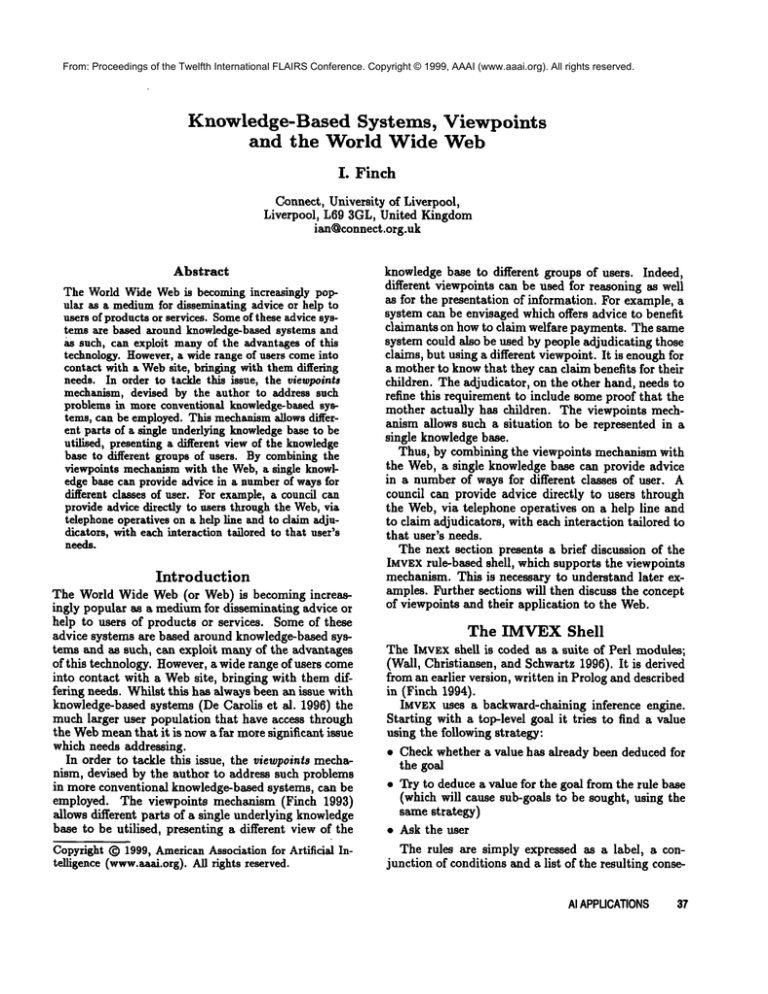
From: Proceedings of the Twelfth International FLAIRS Conference. Copyright © 1999, AAAI (www.aaai.org). All rights reserved.
Knowledge-Based
and the
Systems,
Viewpoints
World Wide Web
I. Finch
Connect, University of Liverpool,
Liverpool, L69 3GL, United Kingdom
ian@connect.org.uk
Abstract
The World Wide Webis becoming increasingly popular as a mediumfor disseminating advice or help to
users of products or services. Someof these advice systems axe based around knowledge-based systems and
as such, can exploit manyof the advantages of this
technology. However,a wide range of users comeinto
contact with ffi Website, bringing with themdiffering
needs. In order to tackle this issue, the viewpoints
mechanism, devised by the author to address such
problems in more conventional knowledge-basedsystems, can be employed.This mechanismallows different parts of a single underlying knowledgebase to be
utilised, presenting a different view of the knowledge
base to different groups of users. By combiningthe
viewpoints mechanismwith the Web, a single knowledge base can provide advice in a numberof ways for
different classes of user. For example, &council can
provide advice directly to users through the Web,via
telephone operatives on a help line and to claim adjudicators, with each interaction tailored to that user’s
needs.
Introduction
The World Wide Web (or Web) is becoming increasingly popular as a mediumfor disseminating advice or
help to users of products or services. Someof these
advice systems are based around knowledge-based systems and as such, can exploit many of the advantages
of this technology. However,a wide range of users come
into contact with a Website, bringing with them differing needs. Whilst this has always been an issue with
knowledge-based systems (De Carolis et al. 1996) the
much larger user population that have access through
the Webmeanthat it is nowa far more significant issue
which needs addressing.
In order to tackle this issue, the viewpoints mechanism, devised by the author to address such problems
in more conventional knowledge-based systems, can be
employed. The viewpoints mechanism (Finch 1993)
allows different parts of a single underlying knowledge
base to be utilised, presenting a different view of the
Copyright ~) 1999, AmericanAssociation for Artificial Intelligence (www.aaai.org).All rights reserved.
knowledge base to different groups of users. Indeed,
different viewpoints can be used for reasoning as well
as for the presentation of information. For example, a
system can be envisaged which offers advice to benefit
claimants on how to claim welfare payments. The same
system could also be used by people adjudicating those
claims, but using a different viewpoint. It is enoughfor
a mother to knowthat they can claim benefits for their
children. The adjudicator, on the other hand, needs to
refine this requirement to include some proof that the
mother actually has children. The viewpoints mechanism allows such a situation to be represented in a
single knowledgebase.
Thus, by combining the viewpoints mechanism with
the Web, a single knowledge base can provide advice
in a number of ways for different classes of user. A
council can provide advice directly to users through
the Web, via telephone operatives on a help line and
to claim adjudicators, with each interaction tailored to
that user’s needs.
The next section presents a brief discussion of the
IMVEX
rule-based shell, which supports the viewpoints
mechanism. This is necessary to understand later examples. Further sections will then discuss the concept
of viewpoints and their application to the Web.
The IMVEXShell
TheIMVEXshellis codedas a suiteof Perlmodules;
(Wall,Christiansen,
andSchwartz
1996).It is derived
froman earlier
version,
written
in Prolog
anddescribed
in (Finch 1994).
IMVEXuses a backward-chaining inference engine.
Starting with a top-level goal it tries to find a value
using the following strategy:
¯ Check whether a value has already been deduced for
the goal
¯ Try to deduce a value for the goal from the rule base
(which will cause sub-goals to be sought, using the
same strategy)
¯ Ask the user
The rules are simply expressed as a label, a conjunction of conditions and a list of the resulting conseAI APPLICATIONS37
quences. For example, the following rule (whose label
is ’4’) states that any man, under the age of 65, who
is healthy, is not entitled to parish relief:
4: age < 65 k man k healthy=> relief’no
As canbe seenfromthisrule,[MVEXconditions
and
consequences
caneither
consist
of a symbol
anda binding(suchas relief’no)or a numeric
comparison
(such
as age< 65).The conditions
whichconsistsolelyof
a symbolhavean implicit
binding
of ’yes’(so,,anis
reallyroan’yes).
So,thisrulewillsucceed
if thenumericvalueboundto ’age’is lessthan65,thevalue
’yes’is boundto ’man’andthevalue’yes’is boundto
’healthy’.
Iftherulesucceeds,
thisresults
in thevalue
’no’beingboundto ’relief’.
Thisrulemaybe presented
totheuserat somepoint,
inwhichcaseit is displayed
inthefollowing
way:
[1] IF age’<e5
[2] AND roan’yes
[3] AND healthy’yes
[4] THEN relief’no
This is not very friendly, so IMVEX
allows text to be
easily associated with symbols and their values. For
example:
age’<65: you are under the age of 65
man’yes: you are a man
healthy’yes:
you are healthy
relief’no:
you will not be grantedparish relief
These are then used wherever text is presented to
the user, for example the above rule becomes:
Rule 4 states that:
IF you are under the
ANDyou are a man
ANDyou are healthy
THENyou eill not be
relief
Similarly, text can be associated
that they can be understood by the
age of 65
granted
parish
with questions, so
user:
age’question:How old are you
IMVEXalso has various standard features common
to most rule-based systems, notably it can answer the
standard ’why’ and ’how’ questions.
The important thing to note about the current implementation of IMVEX
is its modular nature. It consists of one module which can parse the rule base and
a second module which performs the reasoning as described above (and answers questions as a side effect).
What it does not do is read in a rule base from anywhere, display any output or take any input. An interface module must be written for each desired environment whichperforms
thesetasks.
38
FINCH
|
¯. ¯
.¯
.. :.!
i
".’."...: : :~.: :.. :::
Figure
Line
Rule 4 statesthat:
[1]
[2]
[3]
[4]
I
h Accessing
IMVZXthrough
the Command
Currently, there are two interface
modules for
IMVEX:a simple text-based interface and a Webinterface. Both interfaces currently read in their rule
base from a plain text file. The text-based interface
displays its output to the user’s screen and accepts answers to questions from the keyboard (figure 1). The
Web-basedinterface produces its output as Webpages
and allows the user to click on the answers to their
questions (figure 2).
Otherinterfaces
canbe envisaged,
withthemostobviousperhaps
beingan e-mail
interface.
Indeed,
earlier
workby the authorusede-mailas a communication
mediumbetweenknowledge-based
systems(Finchet
al.1997)although
thisrelied
on a purpose-built
e-mail
useragent.Anotherinterface
couldbe the sameas
theWeb-based
interface
described
above,butinstead
of reading the rule base from a local file on the Web
server, it could be loaded from any other Webserver
on the Internet.
Anotherusefulinterface
modulewouldnot immediately
display
questions
fortheuserto answer,
but
wouldfirstchecka database
to seewhether
theanswer
to thatquestion
hasbeenstoredforsomereason.
For
example,
imagine
a helpline
operator
at a council,
attempting
to answera caller’s
question
abouthousing
repairs.
Thesystemneednotask the operator
about
thestateof repair
of thecaller’s
house,
sinceitcan
getthatinformation
directly
fromthecouncil’s
works
database.
This, then, gives sufficient information about IMVEX
and its workings to understand the remainder of the
examples. Before proceeding, however, it is worth introducing an example scenario which allows a more
concrete discussion of the principles involved.
¯ Anyoneunder the age of 14 with a living parent (who
will be supported by their parents).
Similarly, the following categories of people will be
granted relief:
¯ Widows(from the Quickly case)
¯ Anyone who is unsturdy (since they cannot make
their ownshift)
¯ Children under 14 with no living parents (a definition of orphan)
Menover the age of 65
Womenover the age of 60
Viewpoints
Figure 2: Accessing IMVEXthrough the Web
An Example
Scenario
The domain used as an example in this paper is taken
from (Bench-Capon 1991), and was chosen because
is small enough to understand in its entirety whilst
exhibiting the characteristics of manyreal-world problems. The domainis the parish relief law of a fictional
parish in Elizabethan England. The legislation is that:
Any person shall be provided with parish relief if he
apply to a beadle of the parish, and in the opinion
of that beadle he is deserving of such relief.
Furthermore, there are two test cases which have
extended the parish law. Firstly, it was held that John
Goodbodywas not deserving of relief because he was
a sturdy vagabond who could make his own shift (that
is, he could provide for himself). In the second case,
relief was granted to Mistress Quickly, a widow, when
the judge held that of all people widows and orphans
were the most deserving of relief. This leads to the
following categories of people whoare not deserving of
relief:
¯ Men of goodhealthunderthe age of 65 (fromthe
JohnGoodbodycase).
¯ Marriedwomen(whocanbe supported
by theirhusbands).
¯ Singlewomenof goodhealthunderthe age of 60
(whocanmaketheirownshiftor marry).
The viewpoint mechanism allows a single knowledge
base to provide different perspectives to different users,
emphasising some aspects and hiding others. It has
been discussed at length in other articles, and the interested reader is directed to (Finch 1993) and (Finch
1994) for further information. It is sufficient to discuss here the application of viewpoints to the example
domain, and their implementation within IMVEX.
Consider two participants
in an application for
parish relief: the claimant and the beadle (or his
modern day counterpart, the claim adjudicator). The
claimant makes an application for parish relief and the
adjudicator decides whether that claim is valid. Viewpoints allow both participants to use the same rule
base, but to interact with it and get information in a
way suited to their needs.
The simplest example of this is the presentation of
information. A claimant will want information and
questions targetted at themselves, whilst the adjudicator will want them to refer to the claimant. This can
be easily accomplished by associating viewpoints with
the translations, for example:
relief ’ yes/claJJeant :
you will receive parish relief
relief ’ yes/adjudicator:
the claimant will receive parish
relief
There can still be a ’neutrally phrased’ question in
the rule base, not associated with any viewpoint:
relief’yes:parish relief will be granted
A viewpointis said to be ’active’ or ’inactive’. If the
claimant viewpoint is active, the first form will be used,
whereas the second form will be used if the adjudicator
viewpoint is active. If no viewpoint is active, the form
which is not associated with a viewpoint will be used.
If both viewpoints are active, the earliest form in the
rulebasewillbe used.
Although
thisis a useful
facility,
itis onlya minor
aspect
of theviewpoints
mechanism,
affecting
onlythe
superficial
presentation
of information.
Themajoradvantage
of theviewpoints
mechanism
is theability
to
AI APPUCATIONS39
associate
viewpoints
withpartsof therulebase,
allowingalternative
chainsof reasoning
to be formed,
depending
on theactiveviewpoint.
Consider
thefollowing rulewhichstatesthatsomeonewhois unhealthy
should
be granted
parish
relief:
9: healthy’no
=> relief
Fortheclaimant,
thisis sufficient.
Theywillbe
askedwhether
theyarehealthy.
If theysay’no’,they
willbetoldtheydeserve
parish
relief.
Theadjudicator,
on theotherhand,needssomeproofof theclaimant’s
badhealth,forexamplea doctor’s
certificate.
The
above rule can therefore be madepart of the claimant’s
viewpoint. The adjudicator will have a slightly different version in their viewpoint, incorporating the need
for a doctor’s certificate:
9/claimant:
healthy’no
ffi> relief
9/adjudicator:
healthy’no¯ doc~or_cert=> relief
Whentheadjudicator
is usingthe system,
notonly
willtheybe askedwhether
theclaimant
is unhealthy,
theywillalsobe askedwhether
theclaimant
hasa doctor’scertificate.
Thus,by usingviewpoints,
a single
rulebasecanbe usedby botha benefitclaimant
and
the claimadjudicator.
Thishas obviousadvantages
in themaintenance
and development
of therulebase,
sincethereis onlyonerulebaseto maintain.
Furthermore,themodelscanbe contradictory,
as in theabove
example,
wheretheclaimant’s
rulefor beinggranted
parish
relief
hasdifferent
conditions
to theadjudicator’s
rule.
Scalability
Thissmallexample
illustrates
theprinciples
involved,
butcannotindicate
howtheviewpoints
technique
will
operate
on a largerscale.Theissueof scalability
is
important
in twoways:handling
largerandmorecomplexdomains;
and handling
a largernumberof viewpoints.
Thefirstpointto noteis thattheviewpoints
mechanismeffectively
reduces
thecomplexity
of a domain
(as
it isrepresented
in a knowledge
base),
sinceit removes
partsof the knowledgebaseduringreasoning.
The
searchspaceis therefore
reduced
andsmallersearch
treescanbe builtand traversed.
However,
the price
forthis,is a greater
effort
needed
tocreate
andmaintaintherulebase.Thisis onlyan issuewhendifferentviewpoints
contain
contradictory
models,
in which
casecaremustbetakenassigning
rulesto theappropriateviewpoint.
Thereis insufficient
spaceto present
a
morecomplex
examplehere,buttheinterested
reader
is directed
to a fuller
discussion
of thisdomain,
usingviewpoints
to resolve
several
contradictions
(Finch
1994)andalsoa discussion
of a morecomplex
domain,
involving
electrostatic
hazards
in thepetroleum
industry(Finch1993).
Movingon to consider
theissueof a largenumber
of viewpoints,
thisis particularly
relevant
to theWeb,
40
FINCH
since there could be hundreds or thousands of diverse
users accessing a system through the Web. Although
this seems a huge problem, it is important to note some
points. The first is that the knowledgebase (and its
viewpoints) will be centered around a single domain, so
the users of the system can never be too disparate. An
examplemay be a system to offer help in repairing domestic appliances. This could cater for the homeuser
(offering suggestions such as changing a fuse) and also
for a skilled service engineer (offering detailed information about replacing the power supply). However,
since ’boiling an egg’ is not part of the ’repairing domestic appliances’ domain, there will be no viewpoints
for how to use the appliance.
The second point to note is that the viewpoints are
pre-defined; a user cannot define a new viewpoint specific to themselves (at least, not yet). So, continuing
with the domestic appliance theme, there might be a
third category of user (somewhere between the home
user and the skilled service engineer) who can perform
simple repairs (say, replacing an element in an electric
cooker) and is not catered for by the existing viewpoints. In the current approach, this would require
the knowledge base engineers to create the viewpoint
and then add whichever rules are appropriate for that
viewpoint.
It is hoped that in the future, users will be able to
create their ownviewpoints ’on the fly’. The first step
towards achieving this is to create micro-viewpoints
from which the viewpoints can be assembled. In the
domestic appliance scenario, for example, manymicroviewpoints could be created, each representing slightly
more complex tasks. Rules could then be associated
with each micro-viewpoint (as appropriate).
Then
the viewpoints could be created by listing the microviewpoints which make them up. The home user may
only consist of the simplest micro-viewpoints whilst
the skilled service engineer’s viewpoint contains every
micro-viewpoint. Then, if a new viewpoint is needed
(like the person whocan perform simple repairs), it can
be assembled from the appropriate micro-viewpoints.
Conclusions
The principle of viewpoints has been discussed, together with an example of their application. The versatility of a multi-viewpoint knowledge-based system
has been illustrated, particularly with regard to Webbased delivery of advice. Viewpoints allow:
¯ the presentation of information in different ways to
different users
¯ the use of multiple (possibly contradictory) models
of the same situation
¯ the system to reason differently for different users
A demonstrator system was presented which illustrates the power of this approach by providing a Webbased benefits advice service for the use of a potential benefit claimant and the claim adjudicator (with
more complex set of rules made available). Both systems are driven by the same rule base.
The work described here is a ’proof of concept’ implementation. Future work will use the approach described here in two systems. The first is for a local
council and will offer advice on housing benefit, both
directly to the user (through public access Internet terminals) and through a helpline operator. This will involve interaction with existing databases (as described
earlier)/. The second is for a homeappliance manufacturer to provide support to both their customers and
their service engineers in the field. This is a more ambitious project, since it will also include multimedia
content,
suchas imagesandmovieclips.
References
Bench-Capon, T.J.M. 1991. Using a CommonKnowledge Base in Severed Applications, In KnowledgeBased Systems and Legal Applications, 129-136. London, England: Academic Press.
De Carolis, B.; de Itosis, F.; Grasso, F.; Rossiello,
A.; Berry, D.C.; and Gillie, T. 1996. Generating
Recipient-Centered
Explanations About Drug Prescription. Artificial Intelligence in Medicine 8(2):123145.
Finch, I. 1993. Viewpoints -- Facilitating Expert Systems for Multiple Users. In Database and Ezpert Systems Applications, 4th International Conference Daze
’93, 401-412. Vienna, Austria: Springer-Verlag.
Finch, I. 1994. A Mechanismfor Creating Knowledge
Bases Supporting Contradictory Models. In Research
and Development in Ezpert Systems, Proceedings of
Ezpert Systems 1994, 188-213. Oxford, England: Information Press Ltd.
Finch, I.; Coenen, F.P.; Bench-Capon, T.J.M.; and
Shave, MJ.R. 1997. Coordinating Human and Software Agents through Electronic Mail. In Cooperative Knowledge Processing, 64-76. London, England:
Springer-Verlag.
Wall, L.; Christiansen T.; and Schwartz R.L. 1996.
ProgrammingPerl. Sebastopol, California: O’Reilly
and Associates.
AI APPLICATIONS41

